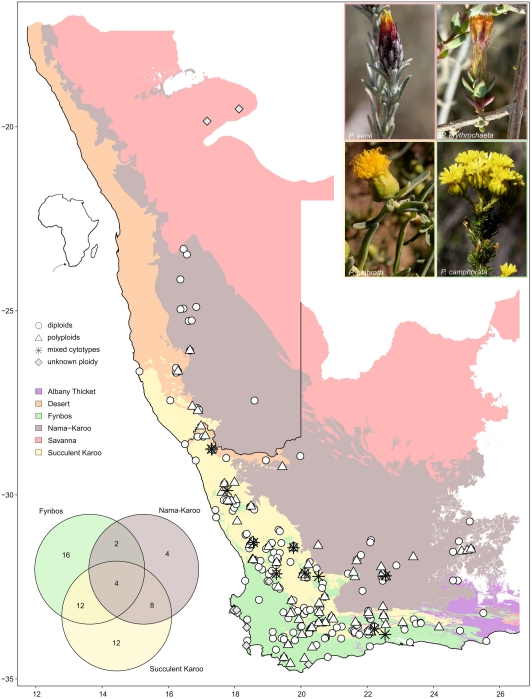The Greater Cape Floristic Region (GCFR) is renowned for its exceptional biodiversity, accommodating over 11 000 plant species, notable degree of endemism, and substantial diversification within limited plant lineages, a phenomenon ascribed to historical radiation events. While both abiotic and biotic factors contribute to this diversification, comprehensive genomic alterations, recognized as pivotal in the diversification of angiosperms, are perceived as uncommon. This investigation focuses on the genus Pteronia, a prominent representative of the Asteraceae family in the GCFR. Employing NGS-based HybSeq and RADSeq methodologies, flow cytometry, karyology, and ecological modeling, we scrutinize the intricacies of its polyploid evolution.  Phylogenetic reconstructions using 951 low-copy nuclear genes confirm Pteronia as a well-supported, distinct clade within the tribe Astereae. The ingroup displays a structure indicative of rapid radiation likely antedating polyploid establishment, with the two main groups demarcated by their presence or absence in the fynbos biome. Genome size analysis encompasses 1293 individuals across 347 populations, elucidating significant variation ranging from 6.1 to 34.2 pg (2C-value). Pteronia demonstrates substantially large genome sizes within Astereae and phanerophytes. Polyploidy is identified in 31% of the studied species, with four discerned ploidy levels (2x, 4x, 6x, 8x). Cytotypes exhibit marked distinctions in environmental traits, influencing their distribution across biomes and augmenting their niche differentiation. These revelations challenge the presumed scarcity of polyploidy in the Cape flora, underscoring the imperative need for detailed population studies. The intricate evolutionary history of Pteronia, characterized by recent polyploidy and genome size variation, contributes substantially to the comprehension of diversification patterns within the GCFR biodiversity hotspot.
Phylogenetic reconstructions using 951 low-copy nuclear genes confirm Pteronia as a well-supported, distinct clade within the tribe Astereae. The ingroup displays a structure indicative of rapid radiation likely antedating polyploid establishment, with the two main groups demarcated by their presence or absence in the fynbos biome. Genome size analysis encompasses 1293 individuals across 347 populations, elucidating significant variation ranging from 6.1 to 34.2 pg (2C-value). Pteronia demonstrates substantially large genome sizes within Astereae and phanerophytes. Polyploidy is identified in 31% of the studied species, with four discerned ploidy levels (2x, 4x, 6x, 8x). Cytotypes exhibit marked distinctions in environmental traits, influencing their distribution across biomes and augmenting their niche differentiation. These revelations challenge the presumed scarcity of polyploidy in the Cape flora, underscoring the imperative need for detailed population studies. The intricate evolutionary history of Pteronia, characterized by recent polyploidy and genome size variation, contributes substantially to the comprehension of diversification patterns within the GCFR biodiversity hotspot.
Deciphering Pteronia's evolution in the Cape Floristic Region: A comprehensive study disputes polyploid deficiency and affirms diploid radiation
Články
